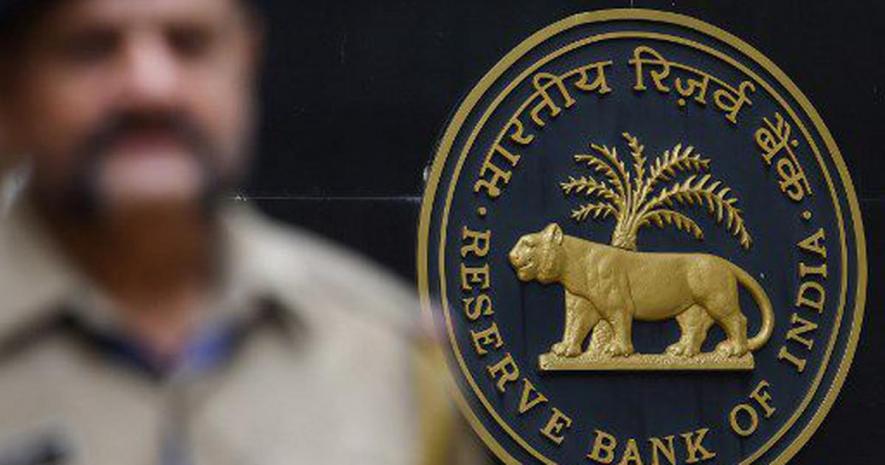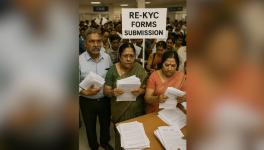RBI Keeps Interest Rate Unchanged; Lowers GDP Growth Forecast

Image Courtesy: AFP
Mumbai: The Reserve Bank of India (RBI) on Friday left key interest rates unchanged at record lows as it reiterated its commitment to keep its monetary policy accommodative, to help the economy recover from the world's worst outbreak of COVID-19 infections.
It also lowered its forecast for the country's economic growth to 9.5% for the current financial year ending March 31, 2022, from the previous estimate of 10.5%.
The six-member monetary policy committee headed by Governor Shaktikanta Das voted unanimously for keeping repo rate -- RBI's key lending rate -- unchanged at 4%, and the reverse repo rate -- the borrowing rate - at 3.35%.
"The MPC was of the view that at this juncture policy support from all sides is required to gain the momentum of growth that was evident in the second half of 2021, and to nurture the recovery after it has taken root," Das said.
It decided to retain an accommodative policy stance "as long as necessary to revive and sustain growth on a durable basis and continue to mitigate the impact of COVID-19 on the economy", signaling there is still room to cut rates further.
RBI expanded its version of quantitative easing to keep borrowing costs anchored. It will buy an additional Rs 1.2 lakh crore of bonds under the Government Securities Acquisition Programme (G-SAP) 2.0 in the second quarter.
In April, RBI committed to buying Rs 1 lakh crore worth of government bonds from the market between April and May under G-SAP 1.0. Under G-SAP 1.0, RBI will purchase government securities worth Rs 40,000 crore this month.
The move is aimed at supporting the government's borrowing plan at comfortable interest rates.
Das said retail inflation is seen at 5.1% in 2021-22, with upside risks from higher commodity prices and re-emergence of higher supply constraints amidst the current phase of lockdowns.
Among the other measures that were announced, RBI allowed banks to borrow as much as Rs 15,000 crore for lending to COVID-hit sectors such as hotels and tourism industry.
Further, an additional Rs 16,000 crore funding has been earmarked for SIDBI for lending to MSMEs, directly or indirectly over and above the quantum of Rs 50,000 crore that was set aside for government financial institutions in the April policy.
In order to provide further relief to the businesses hit by COVID 2.0, the newly announced restructuring window has been extended for all entities with outstanding credit of Rs 50 crore.
RBI had slashed the repo rate by a total of 115 basis points (bps) since March 2020, to soften the blow from the pandemic.
Das said unlike the first wave of COVID-19 infections which brought the economy to an abrupt standstill under a nationwide lockdown, the impact of the second wave on economic activity is expected to be relatively contained with restrictions on mobility being regionalised and nuanced.
"In the year gone by, the Reserve Bank has engaged in safeguarding the economy and the financial system from the ravages of the pandemic.
"We have been on continuous vigil - through the first wave; the lull between the waves; and now the second wave," he said adding "maintaining financial stability and congenial financing conditions for all stakeholders is a commitment that we have adhered to assiduously."
GDP Growth Forecast Lowered
The RBI lowered the country's growth projection for the current financial year to 9.5% from 10.5% estimated earlier, amid uncertainties created by the second wave of the coronavirus pandemic.
Das said the sudden rise in COVID-19 infections, and fatalities has impaired the near nascent recovery that was underway, but has not snuffed it out.
The impulses of growth are still alive, he said, and added that the aggregate supply conditions have shown resilience in the face of the second wave.
Das further said the measures announced on Friday, in conjunction with other steps taken so far are expected to reclaim the growth trajectory from which "we have slid".
In April, the Reserve Bank had projected the real GDP growth for 2021-22 at 10.5%.
India's economy had contracted by less-than-expected 7.3 per cent in the fiscal year ended March 2021, after growth rate picked up in the fourth quarter. The gross domestic product (GDP) grew by 1.6 per cent in the January-March period, up from 0.5 per cent in the previous quarter.
Retail inflation at 5.1% in FY22
RBI projected the retail inflation at 5.1% in the current financial year ending March 31, 2022.
Das said the CPI (Consumer Price Index) inflation is projected at 5.1% during 2021-22.
This consists of 5.2% in the first quarter, 5.4% in the second quarter, 4.7% in the third quarter and 5.3% in the fourth quarter of this fiscal, with risks broadly balanced, he said.
According to Das, upside risks to inflation emanates from persistence of second COVID wave and consequent restrictions on activity on a virtually pan-India basis.
"In such a scenario, insulating prices of essential food items from supply side disruptions will necessitate active monitoring and preparedness for coordinated, calibrated and timely measures by both Centre and state governments to prevent emergence of supply side bottlenecks and increase in retail margins," the governor said.
Get the latest reports & analysis with people's perspective on Protests, movements & deep analytical videos, discussions of the current affairs in your Telegram app. Subscribe to NewsClick's Telegram channel & get Real-Time updates on stories, as they get published on our website.
























